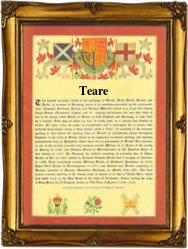This unusual surname is a Manx contraction of the Scottish "M(a)cintyre", itself an Anglicized form of the Old Gaelic "Mac an tSaoir", son of the craftsman, from "Mac", son of, with the definite article "an", and "saoir", genitive of "saor", artificer, craftsman, wright. The Mcintyre clan were hereditary foresters to the Stewarts of Lorn, Argyllshire, and later to the Campbells of Lorn. Glenoe (also written as Glencoe) near Bunawe, Nether Lorn, was the county of this sept, and historically, they appear always to have been subordinate to the chiefs of Upper Lorn. The surname first appears on record in Scotland in the latter part of the 13th Century (see below). The Manx Gaelic versions of the name: Mac y Teyir, MacTyr, Mactere and M'Terre are recorded in the Isle of Man between the years 1372 and 1504. The form Mac TereBoy, coming from the Manx Gaelic "Mac y Teyir Wuigh", son of the yellow craftsman or yellow smith (i.e., goldsmith), is both contracted to Teare, and translated as Goldsmith. Two of the several places on the Isle of Man named from this family are Ballateare in Jurby, and Teare's Bridge in the parish of Patrick. On May 17th 1607, An Teare and Dollin Vondy were married at Jurby, and on September 4th 1630, the birth of Jon Teare was registered at Ballaugh, the Isle of Man. The first recorded spelling of the family name is shown to be that of Nicholas Mac in tSair, which was dated 1268, in "The Scottish Macs, Paisley", by J.B. Johnston, during the reign of King Alexander 111 of Scotland, 1249 - 1286. Surnames became necessary when governments introduced personal taxation. In England this was known as Poll Tax. Throughout the centuries, surnames in every country have continued to "develop" often leading to astonishing variants of the original spelling.
© Copyright: Name Origin Research 1980 - 2024

Enjoy this name printed onto our colourful scroll, printed in Olde English script. An ideal gift.
